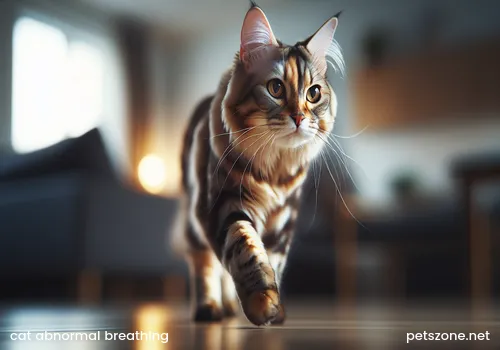Cat Making 'Humph Humph' Sounds Like Nausea_Alert to Potential Health Problems of Abnormal Cat Breathing
Cats making a "humph humph" sound like nausea may be a sign of multiple health problems, ranging from a harmless reverse sneeze to life-threatening emergencies like asthma, heart disease, or foreign objects stuck in the throat. Cat owners must observe carefully and seek veterinary care if necessary.

Cat making “humph humph” like nausea? What exactly is going on?
Many cat owners have experienced this: the “master” at home suddenly makes a strange sound that sounds like vomiting or nasal congestion whining, stretching the neck forward, body lowering, the whole posture looks like forcefully nauseous but nothing is vomited out. Medically, this sound likely indicates a cat's “reverse sneezing” or some respiratory abnormality.
Reverse Sneezing: A likely false alarm
“Reverse sneezing” may sound unfamiliar, but it is quite common in cats. It is not true vomiting or nausea but a reflexive action where the cat rapidly and forcefully inhales air through the nose to try to clear irritants like dust, pollen, secretions, or small hairs from the nasal passages or throat.
Sound characteristics: Reverse sneezing may sound like hiccups, gasping, pig grunts, or a throat blockage attempting to expel something.
Duration: Usually brief, lasting only a few seconds to about a minute, after which the cat returns to normal activities as if nothing happened.
When not to worry too much: If the cat only occasionally exhibits this and quickly recovers without other symptoms, it's generally not a concern. Similar to humans occasionally sneezing to clear their nose, it is a normal body response.
Warning! Potential health issues behind abnormal breathing
However, if the cat frequently makes the “humph humph” nausea-like sound or exhibits other abnormal symptoms, it may not be simple reverse sneezing. It could signal underlying health problems requiring owners to be vigilant and seek veterinary diagnosis promptly.
1. Feline asthma: “allergic rhinitis” of cat airways
Feline asthma is a common chronic inflammatory respiratory disease with mechanisms similar to human asthma. It can be considered the cat’s airway “allergic rhinitis.” When inhaling allergens like dust, pollen, cigarette smoke, fragrances, mold, or certain cat litter dust, airway inflammation causes swelling, narrowing, and excess mucus affecting normal breathing.
Common symptoms:
* Persistent coughing: The most common symptom, often sounding like coughing up hairballs or dry heaving, sometimes producing foam or mucus.
* Wheezing or making a “whooshing” sound: Audible hissing, whistling, or wheezing during breathing.
* Rapid or labored breathing: Noticeably increased rate, heavy chest and abdominal movements, seeming effortful.
* Open-mouth breathing or panting: Rare unless exercising intensely or very stressed; open-mouth breathing at rest signals respiratory distress.
* Special posture: Cats may adopt a “hen squat” with body lowered, neck extended forward, elbows out to breathe harder.
* Decreased activity and lethargy: Caused by hypoxia or discomfort.
High-risk cats: Siamese and Himalayan breeds are more prone to asthma.
2. Chronic bronchitis: The “old problem” of respiratory tract
Chronic bronchitis is a persistent inflammation of a cat’s trachea and bronchi without a clearly identifiable cause. Symptoms resemble feline asthma and are often confused. Inflammation causes tracheal wall swelling and increased mucus secretion, impairing breathing.
Common symptoms:
* Chronic cough: Dry or wet cough, worse in the morning or after exercise, sometimes sounding like choking or phlegm clearing.
* Rapid, labored breathing: Inflamed trachea restricts airflow, causing fast and effortful respiration, sometimes open-mouth breathing.
* Lethargy and loss of appetite: Due to hypoxia and discomfort.
* Wheezing or abnormal sounds: Dry or wet rales may be heard.
3. Respiratory foreign bodies: Accidental swallowing
Cats are naturally curious and may swallow inappropriate items like small toys, grass blades, threads, fish bones, or food remnants. If stuck in the throat, trachea, or esophagus, it can block airways and cause severe “nausea” or choking symptoms.
Emergency symptoms:
* Severe coughing, gagging, or choking: Sudden onset, cat appears very distressed and anxious.
* Frequent swallowing attempts: Trying to swallow or cough out the foreign body.
* Excessive drooling: Due to irritation.
* Restlessness: Shows clear agitation or pain.
* Open-mouth breathing or difficulty breathing: Severe blockage causing hypoxia.
Kind reminder: If foreign body obstruction is suspected, do not attempt to remove it yourself to avoid secondary injury. Seek immediate medical care!
4. Heart disease: The “silent killer” not to ignore
Feline heart disease, particularly hypertrophic cardiomyopathy (HCM), may show no apparent symptoms early but can cause serious breathing issues once heart failure develops. Impaired heart pumping may cause lung fluid buildup (pulmonary edema) or chest fluid accumulation, compressing lungs and resulting in breathing difficulty.
Common symptoms:
* Increased respiratory rate: Especially at rest or sleep; normal cats breathe about 20-30 times per minute, over 40 times per minute requires caution.
* Labored breathing: Marked chest and abdominal movements or open-mouth breathing.
* Abnormal lung sounds on auscultation: Crackles or moist rales like boiling water sounds.
* Blue or pale tongue and gums: Sign of severe hypoxia, requiring immediate vet care.
* Reduced appetite, lethargy, reduced activity: Cats with heart disease may become sleepy and hide.
* Coughing: Less common than in dogs but possible in heart failure.
High-risk cats: Ragdolls, Maine Coons, and flat-faced breeds (Persians, Exotic Shorthairs) are more prone to heart and respiratory issues.
5. Respiratory infections and pneumonia: A common but serious problem
Cats may develop respiratory infections such as feline viral rhinotracheitis, calicivirus, or severe pneumonia. These cause airway inflammation, nasal congestion, runny nose, coughing, affecting breathing.
Common symptoms:
* Increased nasal discharge: Clear, purulent, or bloody secretions.
* Sneezing and coughing: Common infection signs.
* Fever, lethargy, loss of appetite: Systemic signs.
* Breathing difficulty: Severe infection or pneumonia impairs lung function.
6. Other not to be ignored reasons
- Allergy: Besides asthma, allergies to environmental substances (smoke, perfume, cleaners) can cause respiratory discomfort and similar symptoms.
- Pain: Cats in severe pain may breathe rapidly and shallowly to cope with distress.
- Stress or tension: Events like moving, vet visits, or strangers at home may cause temporary rapid breathing, which normalizes when calm.
- Heatstroke: Cats may breathe faster to cool down in hot environments, though they do not pant as dogs do, making panting especially worrisome.
- Obesity: Excess fat presses on the trachea and lungs, lowering breathing efficiency and causing noisy or labored breathing even at rest.
- Anemia: Low red blood cell count reduces oxygen capacity, leading cats to breathe faster to compensate.
- Tumors: Nasal, throat, or lung tumors can block airways and cause abnormal respiration.
How to tell if your cat is really having "breathing difficulty"?
As a cat owner, learning to observe your cat’s breathing is crucial.
Normal respiratory rate:
Cats at rest or sleeping normally breathe around 20-30 times per minute. Kittens might be slightly faster, slower during sleep. Observe the rise and fall of the chest or abdomen; one breath includes an inhalation (chest rising) and exhalation (chest falling).
Red alert signs requiring immediate vet care:
If you notice any of the following in your cat, go to the vet immediately:
* Open-mouth breathing or persistent panting: Clear signs of respiratory distress.
* Significantly increased respiratory rate with heavy abdominal movement: Breathing faster than 40 times per minute at rest with visible abdominal effort.
* Blue or purple tongue, gums, or inner ears (cyanosis): Indicates severe hypoxia, an urgent emergency.
* Unusual sounds when breathing: Wheezing ("whooshing"), crackling, snoring, or choking noises.
* Special breathing postures: Such as hen squat, neck extended forward, elbows out.
* Lethargy, loss of appetite, hiding, unwillingness to move, weakness, or paralysis.
What can cat owners do when they notice abnormal breathing?
When abnormal breathing appears, cat owners should:
- Stay calm: Your anxiety can make your cat more stressed and worsen breathing difficulty.
- Carefully observe and record: Note the time, frequency, duration of abnormal breathing and any accompanying symptoms (coughing, vomiting, mental state, appetite changes). If possible, record a video to assist the vet with diagnosis.
- Avoid forcefully comforting or disturbing: Cats in respiratory distress may be fragile; too much handling can worsen their condition.
- Contact your vet immediately: Even if symptoms seem mild, consult your vet promptly. For emergencies, do not hesitate to take your cat to the nearest emergency pet hospital. Early diagnosis and treatment greatly improve survival chances.
Veterinary diagnosis and treatment: Scientific approach to breathing issues
Because various causes lead to abnormal breathing, vets will perform professional examinations to identify the cause and tailor treatment.
Common diagnostic methods:
- Detailed history and physical exam: Inquiry about cat’s age, breed, medical history, symptom details, listening to heart and lungs, assessing airway condition.
- X-rays (chest films): Important for diagnosing respiratory and heart diseases; can show inflammation, fluid, foreign bodies, heart size, airway collapse.
- Blood tests: Assess overall health, exclude anemia, infection, heartworm.
- Cardiac ultrasound (echocardiography): The gold standard for heart disease diagnosis; evaluates heart structure and function.
- Tracheal wash or bronchoscopy: For asthma and chronic bronchitis diagnosis, collecting airway cells and secretions to analyze inflammation type or exclude infection.
- Fecal exam: To exclude parasites like lungworms.
Treatment principles:
- Symptomatic treatment: Relieve cat's breathing difficulty, such as oxygen therapy and bronchodilators to help easier breathing.
- Cause-specific treatment:
- Asthma/bronchitis: Commonly use oral or inhaled steroids to control inflammation; inhalers have fewer side effects and are effective.
- Foreign object removal: Usually requires endoscopy or surgery.
- Heart disease: Medications to control fluid buildup from heart failure, improve cardiac function.
- Infections: Antibiotics or antivirals.
- Other conditions: Treat specific causes, like correcting anemia, controlling pain, managing obesity.
Daily care and prevention: Building a protective umbrella for your cat’s respiratory health
Though some diseases are hard to completely prevent, attentive daily care can significantly reduce the risk of respiratory problems and improve quality of life.
- Improve indoor air quality:
- Reduce allergens: Avoid fragrant cat litter, air fresheners, scented candles, insecticides, and other irritants.
- Quit smoking: Smoking indoors is a major risk for cat respiratory issues. For your cat's health, quit or avoid indoor smoking.
- Clean regularly: Frequent cleaning reduces dust and mold. Use vacuum cleaners with HEPA filters and wipe furniture surfaces. During cleaning, temporarily separate cats from the room until dust settles.
- Use air purifiers: For sensitive cats, placing an air purifier at home helps filter particles and allergens.
- Maintain proper humidity: Both too dry or too humid environments can irritate airways.
- Choose appropriate cat litter: Prefer dust-free or low-dust litters to reduce dust inhalation during use.
- Control weight: Obesity increases stress on heart and joints and may compress airways, causing breathing difficulty. Maintaining healthy weight is key to prevention.
- Regular checkups: Even healthy-looking cats should have annual full checks. For senior cats or those with potential history, increase frequency. Early detection and treatment prevent small problems becoming serious.
- Avoid stress: Provide a stable, quiet living environment, minimizing unnecessary stressors.
Frequently Asked Questions
Q1: What is the difference between 'reverse sneezing' and 'coughing' in cats?
A1: Reverse sneezing is a rapid inhalation to clear irritants from the nose or throat, sounding like a "humph" or choking sound, and is brief. Coughing expels air to clear respiratory irritants, sounding like "cough, cough," often with dry heaving or foam. Asthma-induced coughs are often mistaken for hairball coughs.
Q2: Is it normal for my cat’s breathing rate to be fast during sleep?
A2: Cats normally breathe 20-30 times per minute during rest or deep sleep. If your cat’s breathing rate consistently exceeds 40 times per minute during quiet times, especially sleep, with heavy chest or abdominal movement or abnormal sounds, it is abnormal, and you should consult a vet promptly.
Q3: Are flat-faced cats (like Persians) more prone to breathing problems?
A3: Yes, brachycephalic breeds such as Persians and Exotic Shorthairs have shorter, narrower airways due to their facial structure, making them more susceptible to nasal narrowing, elongated soft palate, and resulting breathing difficulties or abnormal sounds.
Q4: Is open-mouth breathing in cats always serious?
A4: Except for brief episodes during severe stress, intense exercise, or extreme heat, open-mouth breathing or panting in cats is usually a serious warning sign of respiratory distress and requires immediate veterinary attention.
Summary
Cats making a "humph humph" sound like nausea is a signal from their body that could be a minor incident or a red alert for serious disease. Responsible cat owners must learn to interpret these sounds and closely monitor their cat’s overall condition. Upon detecting abnormalities, especially when accompanied by labored breathing, open-mouth breathing, lethargy, or gum discoloration, do not delay and seek veterinary care immediately. Early detection, scientific diagnosis, and timely treatment are the “golden rules” for protecting your cat’s respiratory health, allowing our furry companions to enjoy a healthy and happy life.
References
- WebMD. What Is Reverse Sneezing in Cats?. 2024-08-17.
- Fanggezi. My Cat Has Feline Asthma: Symptoms / Causes / Prevention & Treatment. 2024-06-18.
- Vetster. Difficulty breathing in cats: Heart or respiratory issue?. 2024-12-13.
- Lake City Animal Hospital. Reverse Sneezing in Cats: Why is My Cat Doing it and is it Normal?.
- Cornell University College of Veterinary Medicine. Dyspnea (Difficulty Breathing).
- Institute of Veterinary Research. What is Cat Asthma? A Detailed Analysis of Cat Respiratory Diseases.
- How to Tell if Your Cat is in Respiratory Distress. 2025-03-06.
- Tencent News. Cat Breathing Rapidly? These May Be the Causes!. 2023-12-16.
- NetEase. Cat "Difficulty Breathing" Cannot Be Underestimated; Finding Underlying Causes is Fundamental; Timely Treatment is Key. 2022-10-02.
- Beyond Pets Animal Hospital. Reverse Sneeze In Cats - Causes, Symptoms & Treatment. 2023-03-11.
- Zoetis Petcare. What is Reverse Sneezing in Dogs and Cats?.
- PetMD. Reverse Sneezing in Cats: What Causes It and When To Worry. 2024-06-10.
- International Cat Care. Asthma and chronic bronchitis in cats. 2024-06-21.
- Cornell University College of Veterinary Medicine. Feline Asthma: What You Need To Know.
- PDSA. Breathing problems in cats.
- PetMD. Foreign Objects Stuck In the Esophagus of Cats. 2022-11-04.
- Furmomo. How Long Does Cat Bronchitis Take to Heal? Symptoms, Causes, and Preventive Measures of Cat Tracheitis. 2025-04-06.
- VetMed Consultants. Cat Has Something Stuck in Their Throat: What's Next?. 2023-09-12.
- PetMD. Heavy Breathing in Cats. 2022-09-30.
- Douban. One in Twenty Cats May Have Asthma. An Article on Causes, Treatment, and Prevention of Cat Asthma. 2021-06-20.
- Merck Veterinary Manual. Introduction to Lung and Airway Disorders of Cats - Cat Owners.
- Tufts University Cummings School of Veterinary Medicine. Heart Disease - Cats.
- Xiaomiao Network. What to Pay Attention to With Cat Asthma?. 2022-08-09.
- Maoqilai. Cat Respiratory Sounds During Seasonal Change? 7 Common Reasons for Breathing Sounds in Cats.
- VCA Animal Hospitals. Congestive Heart Failure in Cats.
- MSD Veterinary Manual. Tracheobronchitis (Bronchitis, Bronchial Asthma) in Cats.
- Infobae. Cats Like Humans May Have Asthma: Everything Needed to Prevent Asthma. 2022-03-25.
- Thornton Vets - Caring Hands Veterinary Hospital. Why is my cat breathing heavy?. 2024-01-23.
- Bo'ai Animal Hospital. Is Cat Rapid Breathing Critical? Analysis of 5 Major Causes and Treatment Timing. 2022-04-19.
- Cumberland Animal Clinic. Signs & Symptoms of Asthma in Cats. 2022-04-30.
- International Cat Care. Cardiomyopathy (heart disease) in cats. 2024-06-21.
- An'an Pet Hospital. Cat Breathing with Large Abdominal Movement. 2024-11-29.
- MSD Veterinary Manual. Pneumonia in Cats - Cat Owners.
- Wikipedia. Feline asthma.
- Cosset Pet Health. Cat Open-mouth Breathing Indicates Serious Chronic Disease! Do Not Ignore!.
- CVCA. 10 Signs of Heart Disease in Dogs & Cats. 2019-07-19.
- MyCPR NOW. First Aid for Cats: How to Safely Remove Foreign Objects.
- Clark Road Animal Clinic. Paws and Breathe: Recognizing and Treating Feline Asthma.
- Clemmons Vet. Causes of Heavy Breathing in Cats. 2021-09-03.
- Springfield Vet. Fluid In and Around a Cat's Lungs. 2022-10-30.
- South Wilton Veterinary Group. Symptoms of Bronchitis in Cats. 2021-05-17.
- VIN. Feline Bronchitis: What Do We Know? What Do We Need? - WSAVA2010.
- Wag!. Bronchitis in Cats - Symptoms, Causes, Diagnosis, Treatment, Recovery, Management, Cost.
- Wag!. Foreign Objects Stuck in the Throat in Cats - Symptoms, Causes, Diagnosis, Treatment, Recovery, Management, Cost. 2016-09-08.
- Sina. What You Need to Know About Cat Bronchitis to Avoid Long-term Consequences. 2019-01-29.
- Bull Pharmaceuticals. How to Diagnose Cat Tracheal Bronchitis.
- Sina. How to Diagnose Cat Tracheal Bronchitis. 2019.12.16.
- wikiHow. How to Clear Respiratory Foreign Bodies from a Cat: 12 Steps.

-560x560.webp)



